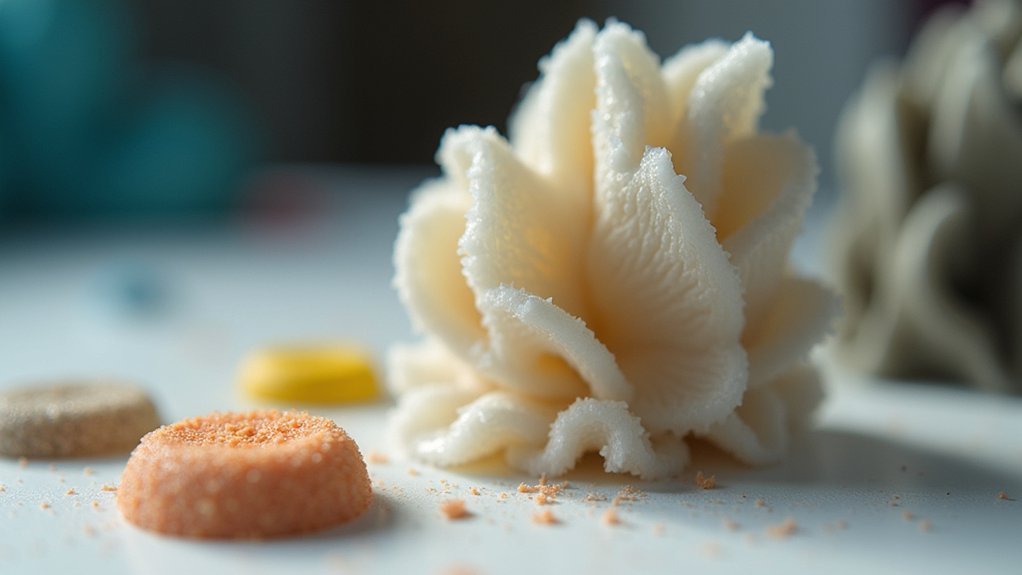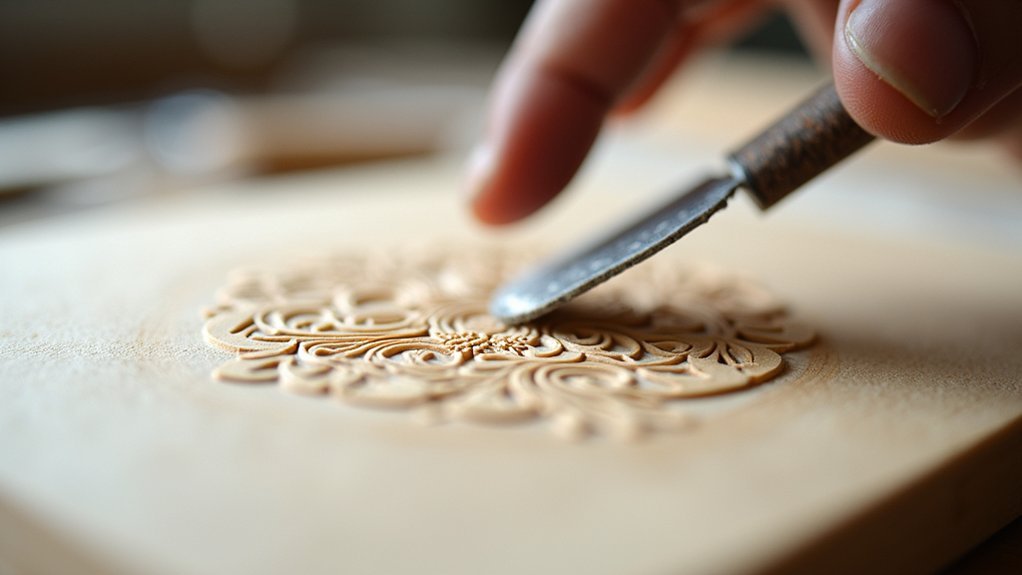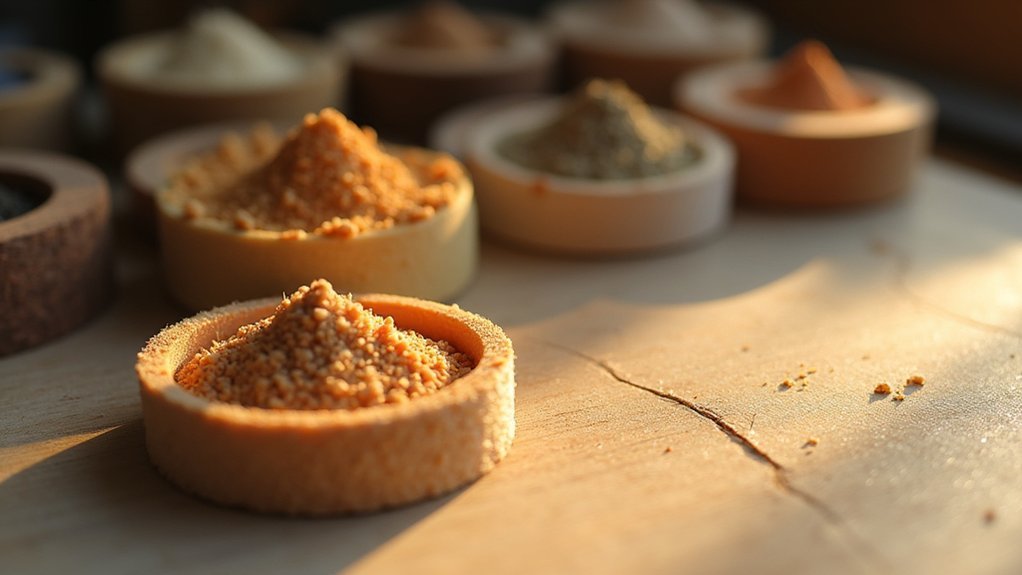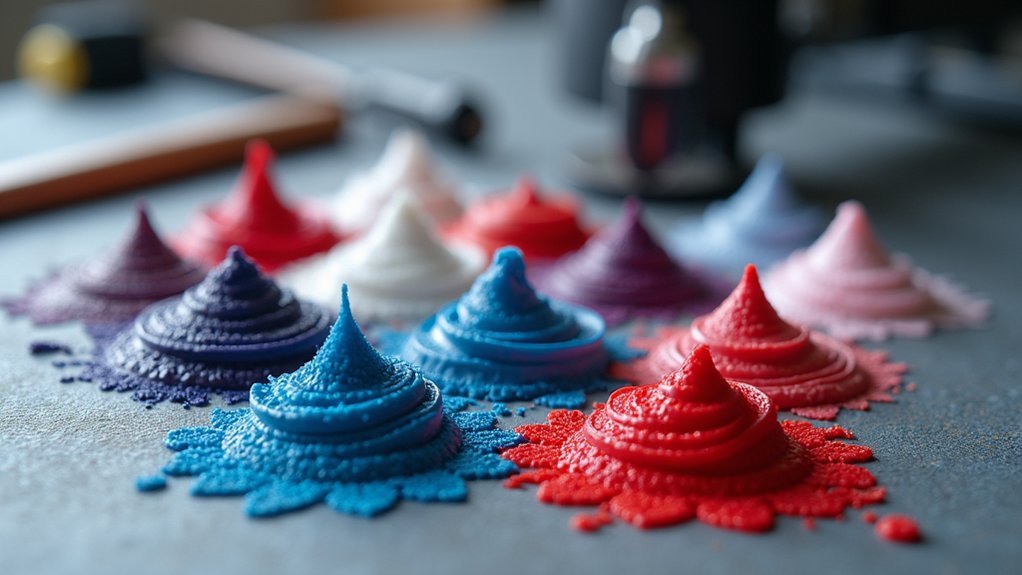Wood filler works best for repairing 3D print flaws because it’s highly compatible with common filaments like PLA, ABS, and PETG. You’ll get excellent results fixing layer lines, surface roughness, and gaps since wood filler bonds well, sands smoothly, and accepts paint beautifully. For best results, you’ll need to clean your print thoroughly, apply thin layers, and allow proper drying time between coats. The specific techniques and brand choices can make all the difference in achieving professional-quality repairs.
Understanding Different Types of 3D Print Flaws and Their Causes

Perfection in 3D printing remains elusive, as various flaws can compromise your prints despite careful preparation.
You’ll encounter layer misalignment and visible layer lines when your printer settings aren’t consistent or mechanical components malfunction. Surface roughness often accompanies these issues, creating an unpolished appearance.
Temperature fluctuations cause warping and curling, especially when your print bed doesn’t provide adequate adhesion.
You’ll notice your prints lifting at corners or edges, distorting the intended shape.
Stringing and oozing leave unwanted filament strands across your print’s surface. These occur when retraction settings aren’t optimized or nozzle temperatures run too high.
Under-extrusion creates gaps and holes throughout your print.
This happens when clogged nozzles or incorrect settings prevent proper filament flow, weakening structural integrity.
Wood Filler Properties and Compatibility With Various 3D Printing Materials
Wood filler’s unique composition makes it an excellent choice for repairing 3D prints, particularly those made from wood-based filaments like PLA Wood composites. These wood fillers combine wood particles with binders, creating a lightweight solution that won’t greatly impact your print’s performance. You’ll find they sand easily to achieve smooth surfaces, ensuring better paint adhesion and professional-looking finishes.
| Property | Advantage | Consideration |
|---|---|---|
| Weight | Maintains lightweight structure | Ideal for performance applications |
| Sandability | Creates smooth, refined surfaces | Enables professional finishing |
| Paint Compatibility | Works with water and oil-based paints | Enhances aesthetic possibilities |
Before applying wood fillers to your entire project, test compatibility on a small area first. They may not bond effectively with highly porous materials or certain plastics.
Preparing Your 3D Printed Surface Before Applying Wood Filler

Before you reach for that wood filler, proper surface preparation will determine whether your repair blends seamlessly or stands out like a sore thumb.
Preparing your 3d printed surface before applying wood filler requires attention to detail and patience. Skip these steps, and you’ll likely face poor adhesion and visible repair marks.
Rushed surface preparation leads to failed wood filler repairs that stick out rather than blend invisibly with your print.
Follow this essential preparation process:
- Clean thoroughly – Remove all dust, grease, and debris from the print surface to guarantee ideal filler adhesion.
- Sand lightly – Use 220-grit sandpaper to create texture that helps the wood filler bond effectively.
- Apply strategically – Fill gaps with thin layers using a putty knife to prevent excessive buildup.
- Wait patiently – Allow 30 minutes to 2 hours for complete drying before sanding smooth.
Step-by-Step Application Techniques for Wood Filler on Print Imperfections
When you’re ready to tackle those print imperfections, you’ll want to work methodically through each application step to achieve professional results.
Start by thoroughly sanding around the flawed areas to create a rough surface that’ll help the filler bond properly. Using your putty knife, press the wood filler firmly into gaps and smooth it level with surrounding surfaces.
Don’t rush the drying process—wait the full 24 hours for complete hardening. Once dry, sand progressively from 120-grit to 220-grit until everything’s flush and smooth.
Clean away all dust particles before applying your filler primer, which creates the perfect base for paint that’ll seamlessly blend with your print material.
Sanding Methods for Wood Filler on 3D Printed Parts

You’ll need to prepare your wood filler application area properly before starting any sanding work.
Your sanding technique should progress systematically through different grit levels to achieve the smoothest possible finish.
Managing heat buildup during the sanding process is essential since excessive friction can damage both the filler and your 3D printed material underneath.
Wood Filler Application Prep
Sand your 3D printed surface with coarse 80-120 grit sandpaper to create the rough texture that wood filler needs for proper adhesion. Proper wood filler application prep determines whether your repair succeeds or fails, making surface preparation critical.
Before applying any filler, you must guarantee ideal conditions:
- Clean thoroughly – Remove all dust, debris, and oils from the surface using a tack cloth or compressed air.
- Check compatibility – Verify your chosen wood filler works with your specific 3D printing material to prevent adhesion failures.
- Assess damage depth – Plan for multiple thin layers on deeper flaws rather than one thick application.
- Prepare workspace – Guarantee adequate ventilation and have progressively finer sandpaper (220-320 grit) ready for finishing.
This preparation prevents common application mistakes.
Progressive Grit Sanding Technique
Once your wood filler has cured completely, the progressive grit sanding technique becomes your pathway to achieving professional-quality results on your 3D printed parts.
Start with 120-grit sandpaper to remove major imperfections and surface flaws effectively. You’ll want to sand in consistent straight lines or circular patterns to maintain an even surface throughout the process.
After initial sanding, switch to 220-grit sandpaper to refine the finish and smooth the surface further. This medium grit prepares your part for better adhesion if you need another coat of filler.
For your final stage, use 320-grit or finer sandpaper to eliminate any visible scratches from previous grits.
Regularly inspect your work between stages, checking for remaining imperfections that might require additional attention.
Heat Management During Sanding
Because excessive heat can permanently damage both your wood filler and the underlying 3D printed material, controlling temperature during sanding becomes critical for maintaining structural integrity.
Effective heat management prevents PLA from melting and keeps your filler from deteriorating during the smoothing process.
Here’s how to maintain proper heat management:
- Use hand sanding exclusively – Power tools generate excessive friction and heat that can ruin your project.
- Keep surfaces slightly damp – Wet sanding techniques reduce friction and dissipate heat buildup effectively.
- Take regular cooling breaks – Stop sanding when the surface feels warm to your touch.
- Monitor temperature constantly – Check the work area frequently to verify it stays cool throughout the process.
This careful approach preserves your print’s integrity while achieving professional results.
Comparing Wood Filler Performance Across PLA, ABS, and PETG Prints
When you’re choosing wood filler for your 3D prints, you’ll find that adhesion properties vary dramatically between PLA, ABS, and PETG materials.
PLA’s rigid structure creates the best bond with wood filler, while ABS and PETG’s flexibility can lead to cracking and delamination issues.
You’ll need to adjust your surface preparation techniques based on each material’s unique characteristics to achieve professional results.
Wood Filler Adhesion Properties
Although wood filler works effectively across multiple 3D printing materials, its adhesion properties vary considerably between PLA, ABS, and PETG prints.
You’ll find that PLA’s porous surface provides the best foundation for strong bonds, while ABS’s smooth finish requires extra surface preparation.
PETG’s flexibility creates unique challenges for maintaining consistent adhesion.
Understanding wood filler adhesion properties helps you achieve professional results:
- PLA compatibility – Natural porosity creates excellent mechanical bonding without additional prep work
- ABS preparation – Sand lightly to create texture for improved filler grip on smooth surfaces
- PETG flexibility – Apply thin layers to accommodate material movement and prevent cracking
- Test application – Always conduct small-area trials before full coverage to verify compatibility
You’ll achieve superior results by matching your technique to each material’s specific characteristics.
Material Compatibility Testing Results
Testing wood filler across different 3D printing materials reveals significant performance variations that you need to understand before tackling your repair projects.
PLA prints show excellent compatibility due to their low porosity and textured surface, allowing wood filler to bond effectively while filling gaps smoothly.
ABS presents challenges with its smoother finish, requiring surface preparation through sanding to improve filler adhesion.
PETG’s flexibility creates the most problems, as wood filler tends to crack or separate when the material bends.
You’ll notice wood filler shrinks slightly during drying across all materials, often requiring multiple applications for ideal results.
Always test compatibility on sample pieces before applying filler to your finished prints.
Surface Preparation Requirements
Since proper surface preparation determines whether your wood filler repair will succeed or fail, you’ll need to tailor your approach based on your print material’s unique characteristics.
PLA’s porous surface accepts filler readily, but you’ll still need light sanding for best results.
ABS requires more aggressive surface preparation requirements due to its non-porous nature—you must rough up the surface considerably to create mechanical adhesion.
PETG presents the biggest challenge, demanding careful preparation that won’t compromise its flexibility.
Essential surface preparation requirements include:
- Clean thoroughly – Remove all support material residue, oils, and debris before applying filler
- Sand strategically – Use 220-grit for PLA, 120-grit for ABS, and 320-grit for PETG
- Test adhesion – Apply filler to a small area first to verify bonding
- Allow proper drying – Wait recommended cure times between coats
Wood Filler Vs Alternative Filling Materials for 3D Print Repair
When you’re deciding between wood filler and alternative materials for 3D print repairs, your choice depends largely on your print material and the type of repair needed.
Wood filler works exceptionally well with wood-based filaments, delivering natural-looking finishes and excellent adhesion to porous surfaces.
However, alternative filling materials often outperform wood filler in specific applications.
Epoxy fillers provide superior bonding strength and durability, making them ideal for structural repairs in plastic prints.
Acrylic fillers offer quick drying times and easy sanding, perfect for minor surface imperfections across various materials.
Polyester fillers bring lightweight flexibility without sacrificing structural integrity, while silicone fillers excel when you need maximum elasticity for parts requiring movement or bending.
Achieving Natural Wood-Like Finishes on Filled 3D Printed Objects
Creating authentic wood-like finishes on your filled 3D printed objects requires careful attention to both material selection and application technique.
Wood fillers specifically designed for porous materials will help you replicate real wood’s texture and appearance effectively.
Here’s your step-by-step approach:
- Apply thin layers – Multiple thin coats of wood fillers guarantee better adhesion and fill gaps completely.
- Sand progressively – Start with 120-grit and work up to 320-grit for smooth, realistic texture.
- Create grain patterns – Use wood grain tools or texture rollers after filling to mimic natural wood.
- Finish with stain – Apply water-based wood stain to bring out grain patterns and add rich color.
This technique transforms your 3D printed objects into convincing wood replicas.
Common Wood Filler Application Mistakes and How to Avoid Them
You’ll encounter several common pitfalls when applying wood filler to your 3D prints that can ruin your final finish.
These mistakes often stem from rushing the process or skipping essential preparation steps.
Understanding these errors and their prevention methods will save you time and guarantee professional-looking results.
Wood Filler Application Errors
Although wood filler can effectively repair 3D print flaws, improper application techniques often create new problems that compromise your final results.
Wood filler application errors range from surface preparation oversights to material compatibility issues that affect long-term durability.
Common mistakes include:
- Skipping surface preparation – Poor adhesion occurs when you don’t properly clean or prepare the 3D print surface before applying filler.
- Over-applying layers – Thick applications lead to excessive sanding and uneven finishes instead of building up thin coats.
- Rushing drying time – Insufficient curing between applications causes cracking and compromises repair integrity.
- Using incompatible fillers – Certain materials don’t adhere well to specific 3D print filaments, especially porous ones.
Always test small area applications first to verify compatibility and achieve desired results.
Prevention and Best Practices
While many application errors stem from rushing the process, implementing proper preparation techniques and methodical application practices will help you achieve professional-quality repairs on your 3D prints.
| Step | Best Practice | Prevention Focus |
|---|---|---|
| Surface Prep | Always sand before applying | Prevents peeling and poor adhesion |
| Testing | Test on small area first | Avoids material compatibility issues |
| Application | Use putty knife at slight angle | Prevents excess buildup and rough spots |
| Layer Building | Apply thin layers, build up gradually | Prevents over-application and excessive sanding |
| Drying Time | Allow 24 hours between coats | Guarantees ideal curing and finish quality |
You’ll find that prevention starts with proper surface preparation and continues through each application step. Take your time with each layer, and you’ll avoid the most common mistakes that lead to poor results.
Drying Times and Curing Considerations for Wood Filler Applications
Since wood fillers don’t cure at the same rate across different products and conditions, you’ll need to plan your 3D print repair timeline carefully.
Most wood fillers require 24 hours for complete curing, though drying times vary considerably based on humidity and temperature. While some products dry to the touch within 15-30 minutes, they won’t reach full strength immediately.
Consider these essential timing factors:
- Follow manufacturer instructions for specific drying times rather than relying on general guidelines.
- Allow complete drying between layers when applying multiple coats to prevent moisture trapping.
- Use fans or dehumidifiers in high humidity environments to accelerate the curing process.
- Test on small areas first to gauge actual drying times for your specific conditions.
Staining and Painting Over Wood-Filled 3D Printed Surfaces
When your wood filler has fully cured, you’ll want to create a seamless finish that blends perfectly with your 3D printed surface. Start by sanding the filled area until it’s smooth and level with surrounding material. This step works best when you use progressively finer grits for ideal results.
Before applying any finish, test your chosen stain or paint on a small, hidden area to check compatibility and color matching. Wood fillers accept stains exceptionally well since they contain natural wood fibers that absorb color similarly to real wood.
For painting, apply primer first to guarantee proper adhesion and color vibrancy.
Whether staining or painting, use multiple thin coats rather than one thick application, allowing adequate drying time between layers for even, durable coverage.
Best Wood Filler Brands for Different 3D Printing Applications
Before choosing a wood filler for your 3D printing project, you’ll need to contemplate your specific application requirements and the type of finish you’re targeting.
Different brands excel in various scenarios, so matching the right product to your needs guarantees superior results.
Here are the top wood filler brands for specific 3D printing applications:
- Minwax Wood Filler – Works well for PLA prints requiring smooth, sandable finishes
- Elmer’s Carpenter’s Wood Filler – Perfect for quick repairs on small imperfections with fast drying times
- Bondo Wood Filler – Ideal for larger flaws needing waterproof, durable solutions
- Dap Plastic Wood – Best when you’re planning to stain or paint for natural wood appearances
For flexible prints that experience movement, Smith’s CPES prevents cracking while maintaining strong adhesion.
Advanced Techniques for Large Gap Filling With Wood Filler
When you’re faced with substantial gaps or deep grooves in your 3D prints, standard wood filler application won’t cut it.
You’ll need to master layered application methods that build up the filler gradually, preventing sagging and ensuring proper adhesion in each section.
These advanced techniques require specific approaches for deep groove filling that differ considerably from surface-level repairs.
Layered Application Methods
Although small imperfections in 3D prints can often be fixed with a single application of wood filler, large gaps require a more strategic approach to achieve professional results.
Layered application methods guarantee stronger bonds and prevent the shrinkage that commonly occurs with thick filler applications.
Here’s how to master this technique:
- Prep the surface – Sand around the gap area to create better adhesion between your 3D print and the wood filler.
- Pack each layer tightly – Use your putty knife to press filler deep into gaps, eliminating air pockets that weaken repairs.
- Allow proper curing time – Wait at least 24 hours between applications so each layer hardens completely.
- Sand progressively – After the final layer cures, use increasingly finer grits for smooth surface changes.
Deep Groove Techniques
The most challenging repairs you’ll encounter involve deep grooves that extend well beyond the surface layer of your 3D print. Wood filler excels at tackling these defects when applied correctly. Press the filler into deep grooves using a putty knife, guaranteeing complete cavity filling without air pockets.
| Step | Grit | Purpose |
|---|---|---|
| Initial | 120-grit | Remove excess filler |
| Intermediate | 220-grit | Smooth shifts |
| Final | 320-grit | Perfect finish |
Apply wood filler in thin layers, letting each dry completely before adding another. This prevents cracking and guarantees solid bonding. After curing, sand with progressively finer grits following the table above. Always test compatibility on inconspicuous areas first before treating visible sections.
Long-Term Durability of Wood Filler Repairs on 3D Printed Parts
Longevity concerns often arise when makers consider using wood filler for 3D print repairs, but these materials actually provide exceptional durability when applied correctly.
Wood fillers bond effectively with porous PLA surfaces, creating repairs that withstand daily use and environmental stresses.
Wood fillers create durable bonds with PLA’s porous structure, delivering repairs that endure everyday handling and environmental challenges.
The long-term durability of wood filler repairs depends on several critical factors:
- Material compatibility – Choose fillers specifically formulated for plastic substrates to guarantee peak adhesion.
- Flexibility maintenance – Wood fillers expand and contract with your prints, preventing delamination over time.
- Structural reinforcement – Properly cured repairs actually strengthen weak areas and prevent future cracking.
- Surface preparation – Clean, roughened surfaces create stronger bonds that last years without failure.
You’ll find these repairs maintain their integrity through temperature changes and mechanical stress better than rigid alternatives.
Frequently Asked Questions
What Is the Best Filler for 3D Prints?
You’ll find epoxy fillers work best for significant gaps and structural repairs due to their superior bonding strength. For minor surface imperfections, acrylic fillers dry quickly and sand easily for smooth finishes.
What to Use to Fill 3D Print Seams?
You’ll want to use epoxy fillers for strong, durable seams or acrylic fillers for quick-drying results. Sand the seams first, then apply thin layers for better adhesion and smoother finishes.
Which Bondo to Use on 3D Prints?
You’ll want Bondo Spot and Glazing Putty for small imperfections and fine details on your 3D prints. For larger gaps or structural repairs, use Bondo Body Filler instead.
Is 10% Infill Okay?
You’ll find 10% infill works fine for decorative items and prototypes, but it’s too weak for functional parts. You’ll need higher infill percentages for anything requiring strength or durability.





Leave a Reply